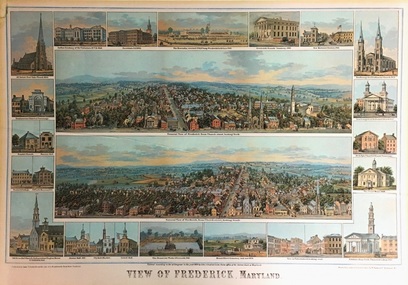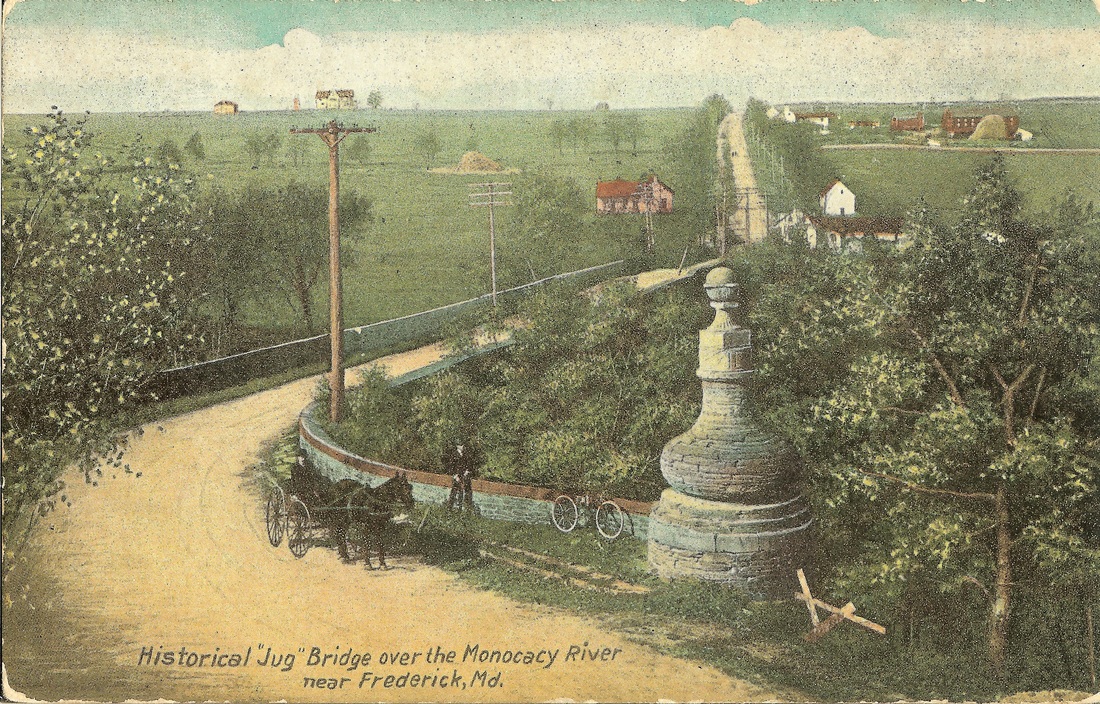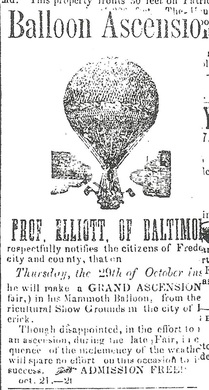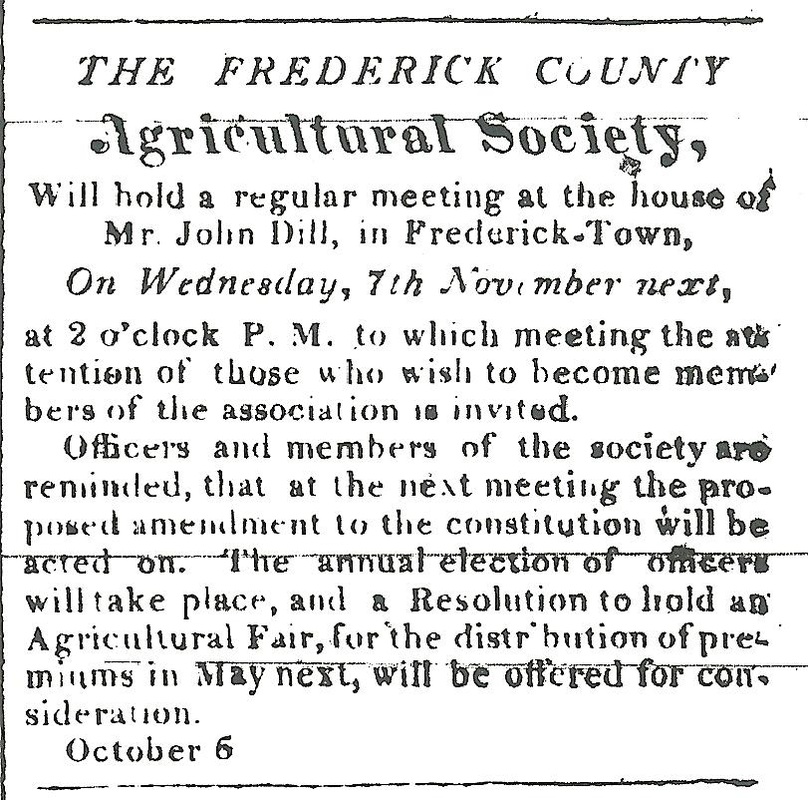HSP HISTORY Blog |
Interesting Frederick, Maryland tidbits and musings .
|
|
Author's Note: This is part 2 of a multi-part history covering the early history of the Great Frederick Fair. Part 1 can be found in the September 2016 archives to the right.  Frederick Examiner (January 12, 1853) Frederick Examiner (January 12, 1853) On January 12th, 1853, a small advertisement in the Frederick Examiner newspaper announced an upcoming meeting, which respectfully invited “all who feel an interest in the advancement of Agriculture” to attend. This ad was placed by members of the Farmer’s Club, organized in 1849. In another part of the same paper, the Examiner’s editor pointed out the meeting as being “well worth the attention of farmers, millers, and all others interested in the development of the productive resources of our county. Its object is to revive and reorganize the Society, and it is to be hoped that a becoming interest and enterprise will be manifested in the important undertaking. “ This meeting took place on January 22nd, 1853 at the Frederick Academy building, where a large and highly respectable assemblage convened and organized an association under the title of the Agricultural Club of Frederick County. High spirit and enthusiasm abounded and a Constitution and By-Laws were adopted along with an election of officers featuring Col. Lewis Kemp as President. The particular goal of the meeting was to make arrangements for holding a local Agricultural Fair for the following fall season.  The First Exhibition of the Frederick County Agricultural Society was held October 16-18th, 1853 and attended by thousands of eager visitors, far exceeding the numbers imagined by the organizers. The home for the newly revived cattle show, fair and exhibition was the Frederick Barracks Grounds on Cannon Hill.  Excerpt from the 1858 Bond map of Frederick City. Excerpt from the 1858 Bond map of Frederick City. The barracks had been built in 1777 by order of the Maryland legislature, so that a military post would be established for foreign prisoners. English officers and Hessian mercenary soldiers would be incarcerated here during the Revolutionary War, and British prisoners again would be kept during the War of 1812. The new location for the Society’s Exhibition was praised for its proximity to transportation lines. Turnpike tolls on the roads into town were suspended for exhibitors and no freight charges were exacted for show goods carried on the B&O railroad. Of major note was the elevated position of the event, overlooking the city basin with commanding views of the surrounding Catoctin Mountain and Monocacy Valley. The following description comes from the Frederick Examiner newspaper: The grounds were securely enclosed and nearly surrounded by a line of stables, stalls, pens and mews, for the protection and show of stock. The old Barracks were used for offices and exhibiting rooms for household goods and domestic manufactures, and a spacious shed erected for the arrangement of vegetables, fruits, grains, meats, seeds, etc. Chicken coops and machinery and agricultural implements comprised the middle area and the lower division contained a plowing lot and a horse ring, about 200 yards in circumference with a judges stand in the center, from which towered a lofty flag bearing the national banner. Upon the stand Capt Burke’s brass band was stationed and from time to time played the choicest pieces, adding considerably to the gaiety and enjoyment of the scene. The horse ring was constantly encircled by a dense mass of spectators, fine ladies vying with noisy men and boys for good points of view; yet we believe all were gratified, and can safely say equally surprised.  Margaret S. Hood (1833-1913) Margaret S. Hood (1833-1913) Hood College benefactor Margaret Scholl Hood would record in her diary: “There was lots of people there. The grounds crowded; everyone says there was never so great a crowd in Frederick since Lafayette came to town.”  E. Sachse & Co. "View of Frederick City, Maryland" (1854) E. Sachse & Co. "View of Frederick City, Maryland" (1854) One year later, the second Annual Exhibition of the Frederick County Agricultural Society took place. The B&O Railroad showed great endorsement of the event by offering fair excursionists free round trip tickets from all stations between Baltimore and Piedmont. The same exuberance of the 1853 event was again demonstrated in year two as it was estimated that 15,000 people attended the second day alone. The “beefed up” cattle show featured a new wrinkle with an equestrian competition conducted by ladies. Another highly touted aspect was the public unveiling and display of a recently completed color lithograph entitled “View of Frederick City, Maryland” by E. Sachse & Co. and published by John Schofield. The 1854 exhibition concluded with an address from Dr. James Higgins, State Agricultural Chemist.
In 1858, the Sixth Annual Exhibition included a Grand Tournament of Jousting. This event would be witnessed by an estimated 10,000 spectators. The 30 participants, or knights, were properly attired and rode in procession through the city en route to the Barracks Grounds. The victors received premiums and the honor of selecting the Queen of Love and Beauty, and three Maids of Honor. After several hours, Henry Dunlop “Knight of Otterburn” was declared champion and promptly chose Miss Marian Buckey, Queen of Love and Beauty.
 Storming of the engine house in Harpers Ferry (October 17, 1859) Storming of the engine house in Harpers Ferry (October 17, 1859) In 1859, the Frederick County Agricultural Society was given a respite from presenting it’s own event as Frederick received the distinct honor of hosting the 20th Annual Exhibition of the Maryland State Agricultural Society from October 25-27, 1859. As the town and county busily made preparations throughout September into October to welcome farmers and visitors from around the state and beyond, a nearby “farmer” known by the name of Isaac Smith was making final plans of his own for an event that would make and shape our Nation’s history. Farmer Smith was actually John Brown, and he was readying his band of followers for a deadly raid on the Union military arsenal at Harpers Ferry. Brown had been staging for this event at the Kennedy farm, just over the Washington County line in Pleasant Valley. When Brown put his ill-fated insurrection plan into effect on the night of October 16th, word reached Frederick by rail the next morning and the nation was alerted of the events from here. Members of Frederick’s fire companies/militia units which had made such a nice display of arms at the 1858 Agricultural Exhibition, now had to put their military training to practical use as they were hurried to Harpers Ferry, among the first responders on the scene. They would assist Col. Robert E. Lee, Capt. J.E.B. Stuart and the US Marines in the successful capture of Brown and his surviving men. Amidst the local and national excitement this event would have on the local citizenry, the Maryland State Fair commenced at the Frederick Barracks Grounds on October 25th and dictated an excellent exhibition with banner attendance. Hotels were filled, and county residents extended their hospitality, and their business goods and inventories, to throngs of tourists. Of particular interest during this event were the simultaneous benefit events being held by the Ladies auxiliaries attached to fire companies of Frederick. A newspaper account from October 26th reported that the United’s had “on exhibition the hat and a pistol belonging to “old” Brown, a Sharp’s Rifle and a Litchfield Spear, captured by the Guards at Harper’s Ferry.” Meanwhile the Junior Defenders performed military drills for audiences with the accompaniment of The American Band.  The Seventh Exhibition of the Frederick County Agricultural Society was held in October 1860. Unfortunately, the return of the Frederick County Exhibition was clearly overshadowed by the excitement and anticipation tied to the hotly contested US Presidential election between Abraham Lincoln, Stephen A. Douglas, John Breckinridge and John C. Bell. To its credit, the Society smartly presented two special event features on site that made the Exhibition an “uplifting” success.  “The bad luck that has heretofore attended all attempts at aerostation in this city, was broken through by Mr. John A. Light, who, on the afternoon of October 6th, under the auspices of the Agricultural Society, made a daring and brilliant ascension from the Show Grounds of the Society, in his Montgolfier Balloon...He shot up like an arrow to the height of five or six hundred feet and was gently wafted over the city, until he finally descended in Love Lane, near the intersection of Fourth St. His progress was witnessed by admiring thousands, whom he saluted in passing by waving his hat. “ The Frederick Examiner newspaper October 13, 1860  The second event of note was a Grand Military Parade and Review to commemorate the Battle of Yorktown. The city militia units were joined by county companies such as the Linganore Mounted Guard, Liberty Riflemen, Carrollton Manor Mounted Guard and three others from beyond the county. The highlight of the parade was the inclusion of the “United Brothers of the War of 1812,” led by Major Gen. Anthony Kimmel, a New Market resident and veteran of the Battle of North Point. The military pomp and circumstance displayed at the recent fairs were certainly an omen of things to come. Within weeks, residents would see Abraham Lincoln elected as their new president. Southern states would immediately start seceding from the Union in the months to follow. The official first shots of war occurred on April 12th, 1861 in Charleston, South Carolina as Fort Sumter was fired upon. Virginia would join the Confederacy less than a week later and on April 19th, an angry mob in Baltimore attacked federal troops from Massachusetts who were trying to make their way through town.  US General Hospital #1 US General Hospital #1 Frederick would become the state capital during the spring and summer 1861. In August, the Potomac Home Brigade was formed as local Union men enlisted for military duty. Others fled south to join the confederacy, such as former Junior Defender Bradley Tyler Johnson, who would take an active part in forming the 1st Maryland Infantry, CSA. The Frederick County Agricultural Exhibition’s home of the Barracks Grounds was permanently commandeered for its intended purposes and would be converted into a Union Military Hospital. After a successful run of eight years, Frederick County would not host another agricultural fair until 1868. New Home In spring of 1867, the Frederick County Agricultural Society was reformed with the selling of 139 life membership tickets. After tasking a special committee with finding a new permanent home for the Agricultural Exhibition, the Society purchased 21 acres of land from its own Treasurer, Gen. Edward Shriver, former leader of the militia that quelled the John Brown raid. A neighbor, and later Society president, William H. Falconer would also sell land for the “new cause.” Bought for $4,500, these properties were located about a half mile east of Frederick on the north side of the Baltimore Turnpike. Almost immediately, substantial buildings were erected and a race course track was laid out. The Frederick Agricultural Grounds now came into being.  President Ulysses S. Grant (1822-1885) President Ulysses S. Grant (1822-1885) The Ninth Annual Fair of the Frederick County Agricultural Society was held October 12-15th, 1868. The return of livestock was accentuated with a tremendous entry of cattle, sheep and poultry specimens. Fittingly, the guests of honor were national Civil War heroes in the form of President Ulysses S. Grant and Gen. William T. Sherman, among other members of the President’s Cabinet. The president’s visit on the 14th drew a larger than normal audience as was expected, but this added to the greatest attended fair that the county had ever seen. “I have great pleasure in visiting for the first time the city of Frederick of which I have heard so much during the period of the late rebellion, and which, too, stood up manfully for the maintenance of the whole Union. I expected to visit this city some years ago but found myself unable to do so but now have found so many friends, and have been gratified with what I have seen of your Fair and enjoyed of your hospitality, I hope at some future time to visit you again.” Ulysses S. Grant October 14th, 1868  President Grant and his party dined at the Fairgrounds and watched the newest feature to the Frederick event…harness racing, a horse competition in which the animals race at a specific gait (a trot or a pace)while pulling a two-wheeled cart called a sulky. Among the many trials of speed held during this fair, was a $500 premium that went to the horse “Patchen” from Philadelphia who made the mile in 2 minutes and 45 seconds. Owen Bowie, the Governor of Maryland was also on hand for the 1868 event. An avid horseman and breeder of thoroughbreds, Bowie would be responsible for bringing Pimlico Race Track to the state thanks in part to a successful gambling wager made by himself and associates. President Grant would keep his promise, and returned to Frederick and the next fair in October of 1869. In addition to members of his cabinet, a host of former governors and the mayor of Washington DC, the president was accompanied by the United States Marine Band. From Frederick’s B&O Station on Market Street, the band headed a procession of carriages that carried the distinguished visitors to the fairgrounds. President Grant would visit the fair for two days .
3 Comments
 My son Eddie, back in 2012, posing in front of the 1800's Fair History Mural, Null Building, Frederick Fairgrounds. My son Eddie, back in 2012, posing in front of the 1800's Fair History Mural, Null Building, Frederick Fairgrounds. This week marks the 154th edition of the Great Frederick Fair, the largest and greatest county fair in the State of Maryland. The Frederick Fair has quite a storied history, but one I found lacking when it came to its first century of existence. Back in 2012, I took on the task of exploring this "historical black hole" in connection with the 150th anniversary commemoration (of the fair). Most Frederick histories simply repeat the same information written in John Thomas Scharf's 1883 History of Western Maryland of the first exhibition and cattle show taking place on May 23rd and 24th, 1822, at George Creager's Tavern near the Monocacy Bridge, two miles east of Frederick. I immediately went to the newspaper microfilm readers in the Maryland Room of C. Burr Artz Library, and started searching the Frederick Town Herald editions of spring 1822. I found that the tavern was actually called the Monocacy Bridge Hotel and was owned by Levi Hughes. Mr. Creager apparently rented from Hughes and eventually ran into financial hardships resulting in being sued for funds owed his landlord. I was able to piece together the agricultural event's colorful history of the 1800's, and was honored to have the Fair Board exhibit my research findings(complete with appropriate visuals) in the form of a large interpretive mural display in the east entrance to the Null Building at the fairgrounds. It's a tapestry of sorts, actually printed on fabric and pulled taut by a metal frame. In the Beginning In 1818, Maryland created its own state Agricultural Society and hoped to keep pace with the growing trends and “innovations” in farming coming out of Europe and at home in places such as Virginia and the Carolinas. The New England states were holding successful livestock exhibitions in places like Albany, New York and Brighton, Massachusetts. Beginning in 1819, Marylanders were given the opportunity to read about these early agricultural fairs, new farming utensils, improvements in breeding stock and agricultural science advancements with the creation of The American Farmer magazine, a weekly publication of John S. Skinner of Baltimore. Interestingly, Skinner is also well known for his role as a prisoner of war exchange officer during the War of 1812. He partnered with Frederick native Francis Scott Key in the successful negotiation and release of Dr. William Beanes in Baltimore Harbor during the bombardment of Fort McHenry, September 1814. The Maryland Agricultural Society had formed in 1818 and presented its very first Cattle Show and Fair in June 1821 at the Maryland Tavern, four miles west of Baltimore on the Frederick Turnpike. It was a smashing success. Frederick County’s tradition of high quality thoroughbred rearing was exemplified by a sweep of the top equine categories by Frederick residents. Thomas Sheppard’s “Columbia” was considered best horse in show for coach purposes; Nimrod Owings’ stallion “Arrow” won the premium for saddle and farming horse; and Joshua Gist had the best brood mare. The county’s fine showing at the state level helped prompt local action in the formation of the Frederick County Agricultural Society in November 1821. A group of highly distinguished planters and farm owners put together the organization’s bylaws and elected William Elie Williams as their president. Williams was the builder and operator of the large stone grist mill on his plantation farmstead at "Ceresville," so named for the Roman goddess of agriculture and grain, Ceres. However, the new society’s leader was better known for being the son of celebrated Revolutionary War Brigadier Gen. Otho Holland Williams (namesake of Williamsport, MD). The vice presidents of the Society included: Col. Henry Kemp, Col. John McPherson, Col. John Thomas, Mr. James Johnson, Col. G.M. Eichelberger, Mr. W.P. Farquhar, Mr. Jesse Slingluff, Mr. Joshua Delaplane and Mr. William Morsell. The Treasurer was Thomas Shaw and Secretary was Henry Willis.
In the fall of 1823, a second event would be held here at the Hughes-owned tavern location by the Monocacy. The show, however, was not officially sanctioned by all in the local Agricultural Club as it was more of a horse racing festival put on in conjunction with the Frederick County Jockey Club. A multitude of factors contributed to this “no show” as the state Agricultural Society held its Maryland Cattle Show and Fair in Easton, on the Eastern Shore, in November. This was coupled with death of William E. Williams, at the age of 35, that same November after an illness of several months.  the Marquis de Lafayette the Marquis de Lafayette A second official Cattle Show and Fair was considered for late October 1824 but plans were most likely cancelled when the Maryland Cattle Show was postponed to late November in order to accommodate a visit from the “Nation’s Guest,” the Marquis de Lafayette. Lafayette made a year-long tour of America, receiving a hero's welcome at every place he visited as one of the last of the great leaders of the American Revolution. Lafayette had been given membership to the Maryland Agricultural Society and would personally hand out premiums at the rescheduled state event. Meanwhile, a local commission was making arrangements to receive Lafayette here in Frederick County in late December. A Time for Pause After getting off to such a fast and confusing start, the Frederick County Agricultural Society is said to have “languished” and was in need of resuscitation in order “to vie with sister counties in the means necessary to accomplish the designs of such an institution,” stated the Frederick Town Herald. With the premature death of William E. Williams and the cancellation of the 1824 Cattle Show, the opportunity arose for the Frederick County Society to regroup and reorganize in December 1824. John Dill’s Tavern in Frederick became the site of important meetings to accomplish this task. Col. John McPherson was elected President and resolutions were made “to hold a Cattle Show and Fair in the following May or June (1825), at which time it was anticipated to award premiums for the best articles of domestic manufacture, such as cloth, cassimeres, cassinets, flannels, blankets, coverlets, counterpanes, carpeting, sheeting, paper, etc along with implements of agriculture.” A subcommittee was formed to examine the constitution, and amendments would come in the form of pulling a vice president from each of the existing 11 districts of the county along with a board of 12 managers. Another important amendment stated: “That premiums be offered, to encourage domestic fabrics and the cultivation of fruits and that a committee be appointed by the society to receive and examine specimens of fruit grown in the county and to make report of the specimens exhibited, to the next meeting of the committee.” The newly titled Cattle Show, Fair and Exhibition and Sale of Domestic Manufactures would be held on May 26 & 27th, 1825 at the Monocacy Bridge Hotel location, now operated by Mrs. Dorcas Cookerly, the late Mr. Levi Hughes’ daughter. The event was heralded in the local newspaper: “the exhibition having greatly exceeded their anticipations, and excited a more general and lively interest in the prosperity of the Agricultural Society. “ One piece of blue broad cloth, 12 and 3/4yards, manufactured by Alexander H. Brown earned a premium of $5.00 by the Committee on Domestic Manufactures. A hearth rug presented by Miss Mary Ann Morgan won a premium of $3.00 from the Committee on Discretionary Premiums. A highlight of the show included a series of plowing matches between local farmers.  (c) 1900 view of the original "Jug Bridge" looking west toward Frederick from the east side of the Monocacy River. Note the building fronting the right side of road (on upper right of picture) as site of the Monocacy Bridge Hotel. This structure and the vicinity below (extending to the river) was the likely site of Frederick's earliest agricultural exhibitions. The lower white buildings constitute another residence and the Toll House.  The Cattle Show, Fair and Exhibition would be held a final time at the Monocacy Jug Bridge vicinity in 1826, as a resolution by the Society dictated the 1827 event to be held in New Windsor on the land of Major James Atlee. Either by design or not, the 4th annual Cattle Show, Fair, and Exhibition would be held near Liberty Town on May 30 and 31st, 1827. Of notable interest were two particular premiums handed out at this event. One of these went to Frederick’s James Raymond, Esq. for the best Essay, written on the subject of “the comparative economy of free and slave labour.” Mr. Raymond received, as his prize, a set of table spoons inscribed “Free Labour.”  Vintage engraving thought to be an image of bachelor/lawyer Nimrod Owings by French artist Julien de Saint-Memin. Vintage engraving thought to be an image of bachelor/lawyer Nimrod Owings by French artist Julien de Saint-Memin. The other competition of note was a first place premium for the best stallion calculated to improve the breed of quick draught horses which went to Nimrod Owings, for his beautiful young bay horse “Enterprise,” sired by his horse “Arrow,” premium winner at the First Maryland Cattle Show. Owings originally hailed from his family's estate of Fountain Rock, located west of today's Walkersville off Biggs Ford Road. He was infamously known for his love of hunting, gambling, and practical jokes. He owned 52 hounds, one for each card in a deck and is credited for providing much of the "wild game" foodstuffs for the grand banquet and ball held in Frederick for Lafayette on December 30th, 1824. His eventual residence and plantation estate (a few years later) would be Waverly, today's site of Waverly Gardens Apartments and the Manor Apartments on Willowdale Drive. Owings former manor house is the clubhouse/office headquarters of the latter. He is buried beneath Frederick's Memorial Park in what was the Old German Reformed After a run of four (or five) events in a six-year span, the Frederick County Cattle Show, Fair and Exhibition was discontinued and would not return for another 25 years. Click below for Part 2 of this story:
|
AuthorChris Haugh Archives
February 2024
Categories |
Proudly powered by Weebly

















 RSS Feed
RSS Feed